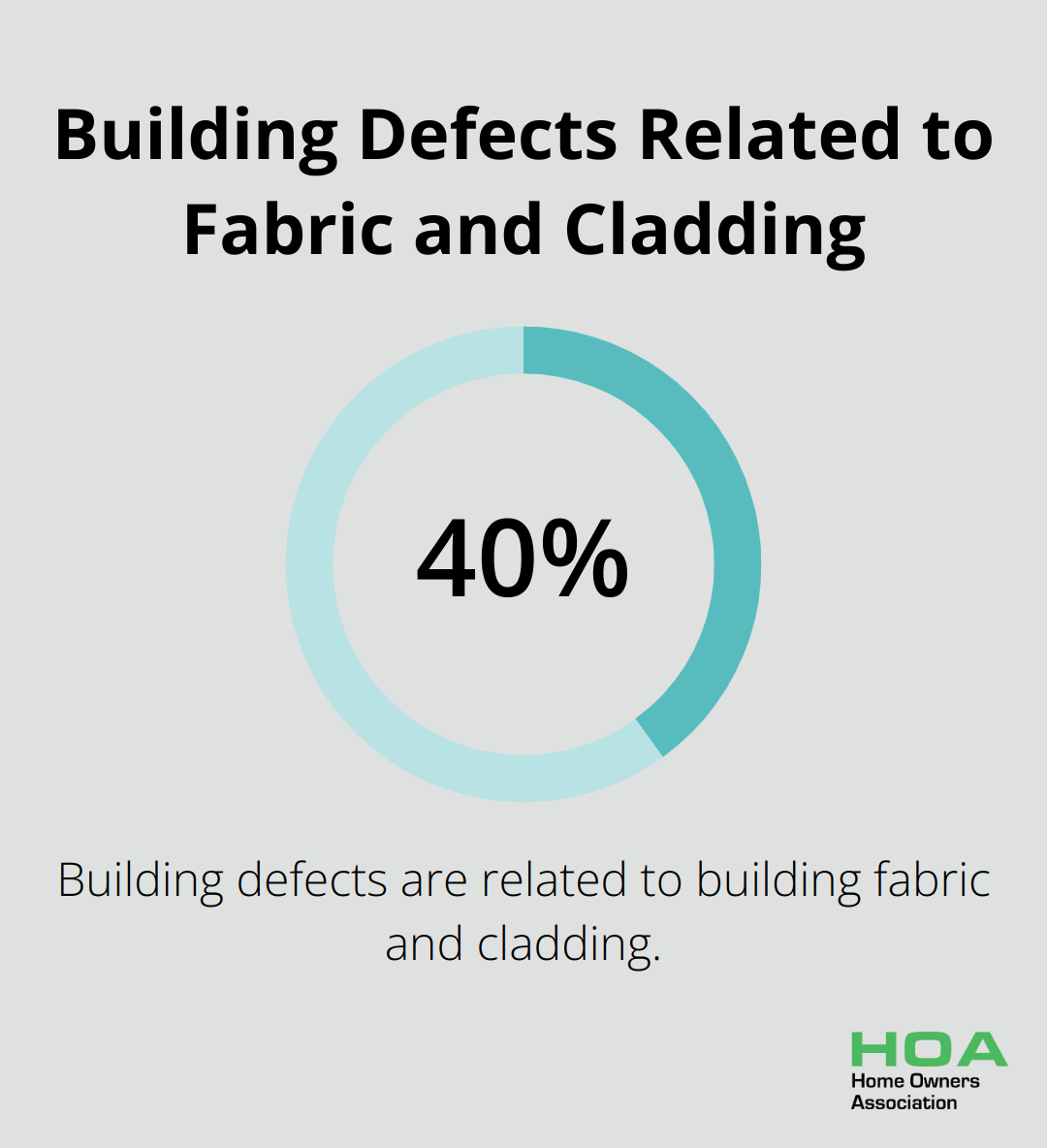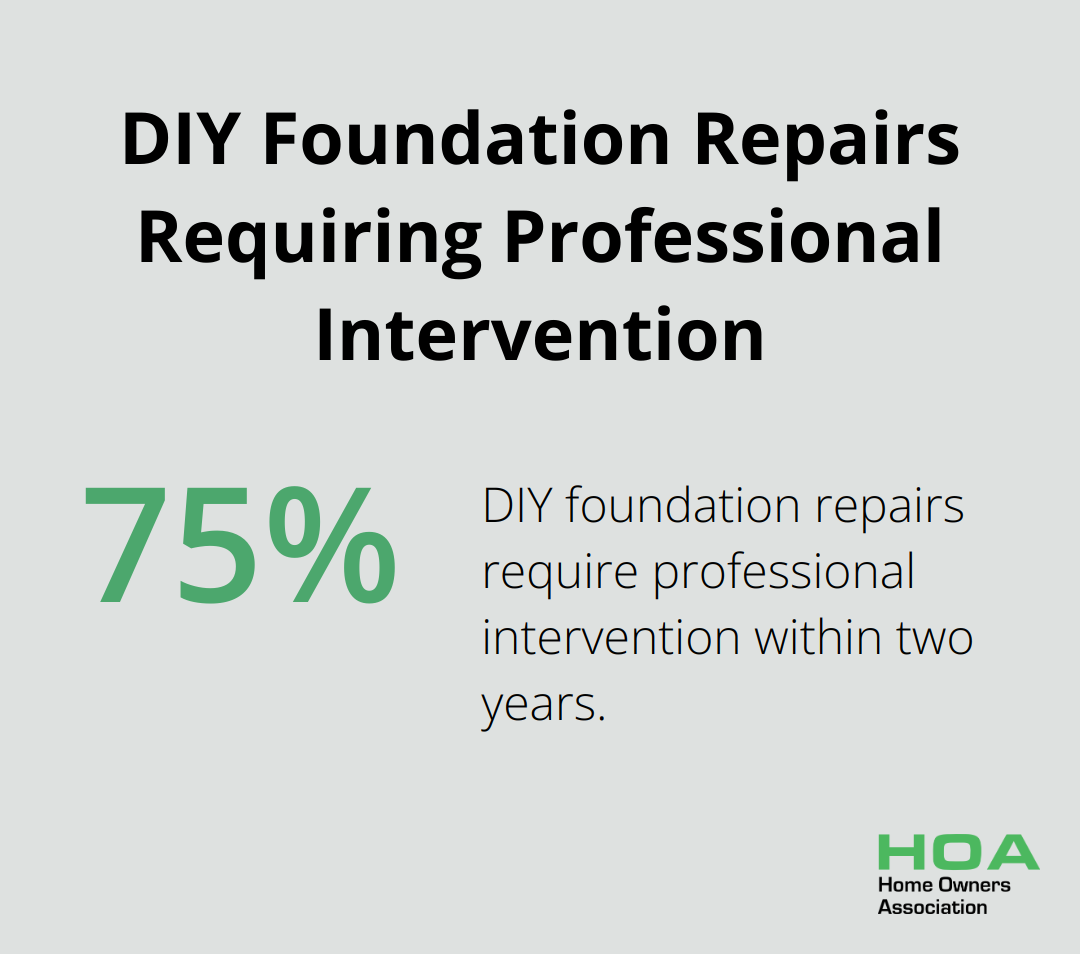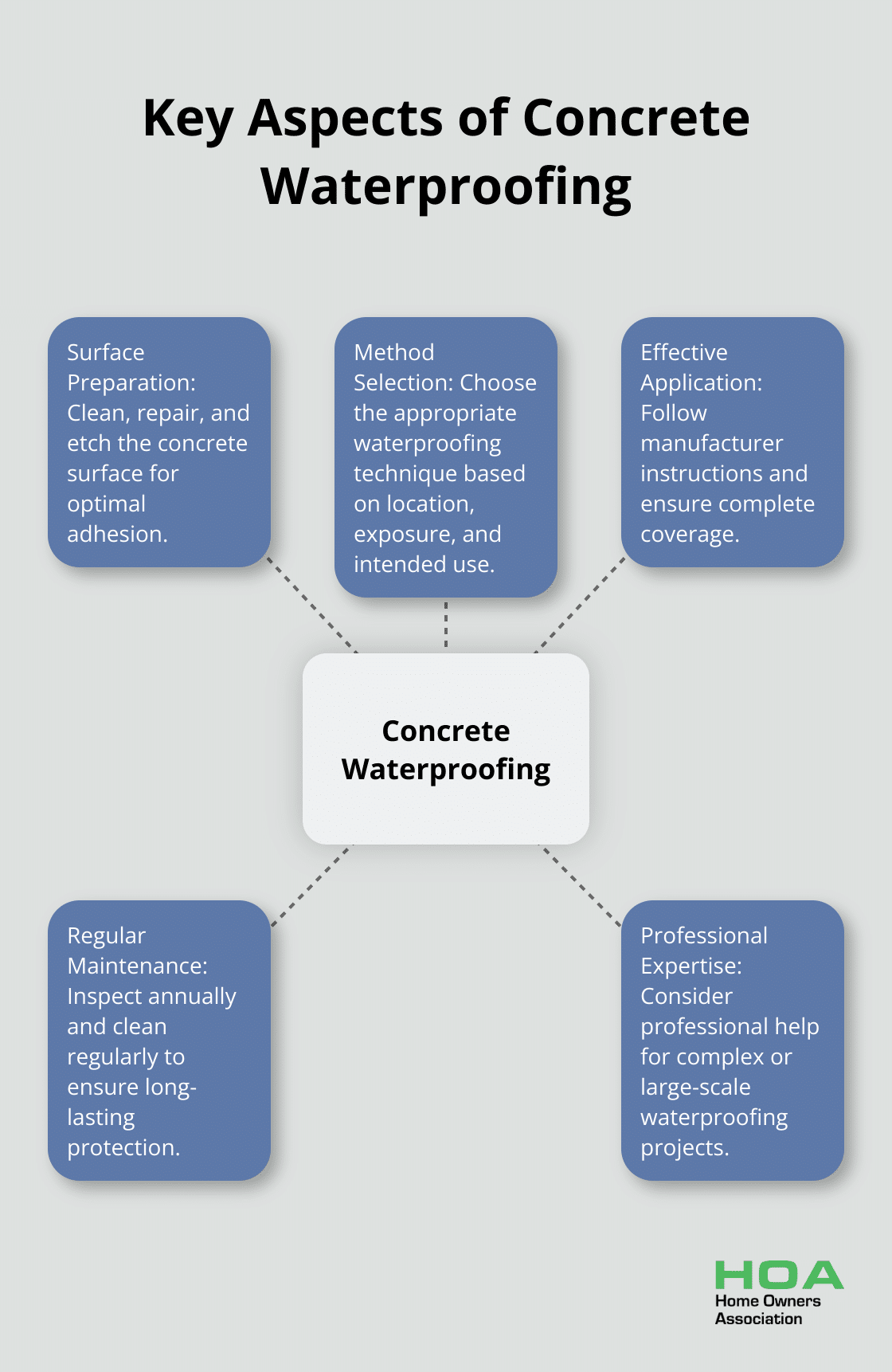
At Home Owners Association, we understand the importance of protecting your property from water damage. Concrete, while durable, is not inherently waterproof and can be vulnerable to moisture infiltration.
Concrete and waterproofing go hand in hand when it comes to maintaining the structural integrity of your home. This guide will walk you through effective methods to safeguard your concrete surfaces, ensuring long-lasting protection against water-related issues.
Why Waterproof Concrete?
The Importance of Concrete Protection
Concrete, while robust, is not impervious to water damage. Water infiltration in concrete structures can lead to a host of problems that compromise structural integrity and safety. At Home Owners Association, we’ve witnessed numerous cases where inadequate waterproofing has resulted in expensive repairs and significant structural issues.
Understanding Water Infiltration Risks
Research indicates that 40.19% of building defects are related to building fabric and cladding. This statistic highlights the critical need for effective waterproofing measures. When water penetrates concrete, it can cause:

- Corrosion of reinforcing steel
- Concrete spalling and cracking
- Mould and mildew growth
- Reduced thermal insulation
- Structural weakening
These issues not only threaten the integrity of your property but can also pose health risks to occupants.
Long-Term Advantages of Proper Waterproofing
Investing in quality concrete waterproofing offers substantial long-term benefits. Recent studies suggest that the use of integral waterproofing admixtures has the potential to increase the service life and improve the durability of concrete structures. This translates to significant savings on maintenance and repairs over time (often outweighing the initial investment).
Selecting the Appropriate Waterproofing Method
The choice of waterproofing technique is paramount to its success. Factors such as the concrete’s location, exposure to elements, and intended use all influence the best approach. For example, below-grade structures require different solutions compared to above-ground concrete surfaces.
We recommend consulting with waterproofing experts to assess your specific needs. They can help you decide between options like crystalline waterproofing (which penetrates deep into the concrete) or surface-applied membranes (that create a protective barrier).
The Cost-Benefit Analysis
The expense of waterproofing is a fraction of potential repair costs if water damage occurs. Proactive protection of your concrete safeguards your property and investment for years to come. (This preventative approach aligns with the Home Owners Association’s commitment to empowering homeowners with cost-effective solutions.)
As we move forward, let’s explore the various methods available for waterproofing concrete, each with its unique advantages and applications.
Effective Concrete Waterproofing Methods
At Home Owners Association, we have observed numerous concrete structures benefit from proper waterproofing. This chapter explores the most effective methods to protect your concrete from water damage.
Surface-Applied Sealers and Coatings
Surface-applied sealers and coatings create a protective barrier on the concrete surface. These products offer quick protection and are easy to apply. Acrylic sealers are popular for their affordability and ease of use, while epoxy coatings provide superior durability and chemical resistance.
A polyurethane coating can extend the life of your concrete driveway by up to 10 years when properly applied and maintained. This type of coating is particularly effective in areas with high UV exposure or frequent chemical spills.
Penetrating Sealers and Densifiers
Penetrating sealers and densifiers seep into the concrete pores, creating a chemical reaction that blocks moisture. These products are ideal for areas where maintaining the original appearance of the concrete is important.
Silicate-based densifiers can increase the surface strength of concrete by up to 40%, making them an excellent choice for high-traffic areas like garage floors or warehouse surfaces. They also reduce dusting by up to 80% (a significant benefit for indoor concrete floors).
Integral Waterproofing Admixtures
Integral waterproofing admixtures are mixed directly into the concrete during the batching process. This method provides comprehensive protection throughout the entire concrete structure, not just the surface.
Studies show that many hydrophobic and crystalline admixtures can reduce the water absorption rate of concrete by up to 80%. This dramatic reduction in water penetration can significantly extend the lifespan of concrete structures, especially in areas with high water tables or frequent exposure to moisture.
External Waterproofing Membranes
External waterproofing membranes are typically used for below-grade structures or areas with constant water exposure. These membranes create a physical barrier between the concrete and water, offering robust protection against hydrostatic pressure.
A properly installed external membrane can withstand water pressures of up to 70 metres, making it an ideal solution for foundations, basements, and underground parking structures. Some advanced membranes even incorporate self-healing technologies, capable of sealing small punctures automatically.
When selecting a waterproofing method, consider factors such as the concrete’s location, exposure level, and intended use. For instance, a basement wall might benefit more from an external membrane, while a concrete patio could be adequately protected with a surface sealer.
The effectiveness of any waterproofing method largely depends on proper application. Studies indicate that 75% of DIY foundation repairs require professional intervention within two years. That’s why we always recommend consulting with waterproofing experts for the best results.

Investing in quality waterproofing now can save you from costly repairs down the line. In fact, data from the construction industry suggests that every dollar spent on preventative waterproofing can save up to $16 in future repair costs.
Now that we’ve covered the various waterproofing methods, let’s move on to a step-by-step guide on how to apply these techniques effectively.
How to Waterproof Concrete Step by Step
Prepare the Surface Thoroughly
The first step in waterproofing concrete is proper surface preparation. A clean, dry, and structurally sound surface ensures the waterproofing material adheres correctly. Start by cleaning the concrete surface with a pressure washer to remove dirt, dust, and loose debris. For stubborn stains or oil spots, use a degreaser or concrete cleaner.
Inspect the surface for cracks, holes, or other imperfections. Repair these before applying any waterproofing solution. Use a concrete patching compound for small cracks and hydraulic cement for larger ones. Allow all repairs to cure fully before proceeding.
For smooth concrete surfaces, consider etching to improve adhesion. Use a concrete etcher or a muriatic acid solution, following all safety precautions. Rinse the surface thoroughly after etching and allow it to dry completely.
Select the Optimal Waterproofing Method
The right waterproofing method depends on various factors, including the concrete’s location, exposure to water, and intended use. For above-grade structures like balconies or patios, a penetrating sealer or surface coating might suffice. These products are easy to apply and provide good protection against rain and surface water.
Below-grade structures such as basements or foundations often require a more robust solution like an external membrane or integral waterproofing admixture. These methods offer superior protection against hydrostatic pressure, which can force water into any crack, gap, or imperfection in the concrete foundation.
Consider the climate and environmental conditions as well. In areas with frequent freeze-thaw cycles, a flexible membrane might work better than a rigid coating. For concrete exposed to chemicals or heavy traffic, an epoxy or polyurethane coating could be the best choice.
Apply the Waterproofing Solution Effectively
The application process varies depending on the chosen waterproofing method, but some general principles apply across the board. Always follow the manufacturer’s instructions carefully, as improper application can lead to failure of the waterproofing system.
For surface-applied products, use a roller, brush, or sprayer to apply an even coat. Work in small sections to ensure complete coverage. Many products require multiple coats for optimal protection. Allow each coat to dry fully before applying the next.
When installing an external membrane, ensure that all seams overlap and seal properly. Pay special attention to corners, joints, and penetrations, as these are common weak points in waterproofing systems.
For integral waterproofing admixtures, mix the product thoroughly into the concrete batch. Proper distribution of the admixture throughout the mix is essential for uniform protection. The most widely used densifiers are various SCMs, such as silica fume, fly ash, and slag.
Care for and Maintain the Waterproofed Surface
After applying the waterproofing solution, proper curing is essential for optimal performance. Protect the treated surface from rain, foot traffic, and other disturbances during the curing period. This can range from 24 hours to several days, depending on the product used.
Regular maintenance ensures long-lasting protection. Inspect the waterproofed surface annually for signs of wear or damage. Clean the surface regularly to prevent the buildup of dirt or debris that could compromise the waterproofing.
For surface-applied products, reapplication may become necessary every few years, depending on wear and exposure. Keep records of when the waterproofing was applied and schedule regular check-ups to determine when reapplication is needed.
(While DIY waterproofing is possible for some projects, complex or large-scale waterproofing jobs often benefit from professional expertise to ensure the best results.)
Final Thoughts
Concrete and waterproofing go hand in hand to protect structures from water damage. The right method, proper application, and regular maintenance ensure long-lasting protection for your concrete surfaces. Quality waterproofing prevents costly repairs, improves energy efficiency, and maintains a healthier living environment.

We at Home Owners Association offer expert advice on concrete waterproofing solutions for Melbourne homeowners. Our team helps you make informed decisions about property maintenance and provides access to the best resources for your projects. Professional expertise often yields the best results for complex or large-scale waterproofing jobs.
Waterproofing concrete is an investment in your property’s future. The initial cost of quality waterproofing leads to significant savings over time. (Proper techniques and materials are essential for lasting protection, whether you’re working on a small patio or a foundation.) Take proactive steps to waterproof your concrete structures and ensure their strength and durability for years to come.





